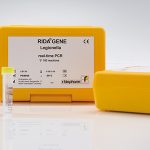Intended use:
For in vitro diagnostic use. RIDA®GENE E. coli Stool Panel I is a multiplex real-time PCR for the direct, qualitative detection and differentiation of genes encoding the virulence-factors of EPEC and STEC, EPEC in human stool samples.
RIDA®GENE E. coli Stool Panel I real-time PCR is intended for use as an aid in diagnosis of gastroenteritis caused by EPEC and STEC, respectively.
General information:
Escherichia coli (E. coli) are gram negative, facultatively anaerobic rod bacteria, which move by peritrichal flagellation and belong to the Enterobacteriaceae family. E. coli are part of the normal intestinal flora of humans and many farm animals and are generally nonpathogenic. Some E. coli strains are pathogenic to humans through the acquisition of certain virulence factors (e.g. genes for toxins).
The six known intestinal pathogenic E. coli: enterohämorrhagic E. coli (EHEC), enteropathogeic E. coli (EPEC), enterotoxic E. coli (ETEC), enteroinvasive E. coli (EIEC), enteroaggregative E. coli (EAEC) and diffusely adherent E. coli (DAEC) can be differentiated by the virulence factors.
Enterohämorrhagic E. coli (EHEC) are currently the most important intestinal pathogenic E. coli. Every year about 1000 cases of illness due to an infection with enterohaemorrhagic E. coli (EHEC) are reported in Germany.
EHEC are a subgroup of the Shiga toxin or Verotoxin producing E. coli (STEC or VTEC) and are capable to produce two cytotoxins, Verotoxin 1 and 2. Due to the similarity of the Verotoxins to the Shiga toxin of Shigella dysenteriae, the VTEC are also called STEC. Another important diagnostic virulence factor for EHEC is the eae gene (E. coli attaching and effacing gene) encoding intimin.
The clinical symptoms which are caused by EHEC range from mild diarrhoeas and severe gastroenteritis to haemorrhagic colitis which occurs in approx. 10 to 20 % of cases of infection. With 5 -10 % of infections, in babies and small children in particular as well as old patients or patients with weakened immune systems, this may also lead to a hemolytic uremic syndrome (HUS) or thrombotic thrombocytopenic purpura (TTP) as a life-threatening post-infectious complication. With HUS and TTP, mortality is particularly high among infants (approx. 10 – 15%). Acute kidney failure with a temporary need for dialysis or an irreversible loss of the kidney function resulting in a constant need for dialysis may occur. The intensity of the clinical picture depends on the predisposition of the patient, but also on the corresponding EHEC phenotype; this means that the progress of the disease also depends on the different ways in which the virulence factors are expressed. Factors, which are still unknown today, also play a role. The incubation period is approximately 2 to 10 days. Because of the high environmental resistance and the infective dose for EHEC is only at about 100 organisms. Sources of infection are contaminated foods from cattle, sheep or goats, particularly raw meat or meat products which have not been heated sufficiently, non-pasteurised raw or certified milk and contaminated fruits and vegetables. Infective chains from human to human, particularly in communal facilities such as kindergartens, homes for the elderly or hospitals, as well as direct contacts to animals are also important.
Enteropathogenic E. coli (EPEC) cause particularly in infants younger than 2 years diarrhea. The virulence factor for EPEC is also the eae gene.
| Art. No. | PG2285 |
|---|---|
| Test format | real-time PCR with 100 reactions |
| Shelf life | 24 months after production |
| Sensitivity | Analytical Sensitivity : ≥ 10 DNA copies per reaction |
Dear customers,
we have started to provide the documents for our products in an electronic format. These are the Instructions for Use (IFU), the Safety Data Sheets (SDS) and the Certificate of Analysis (CoA). For batches placed on the market after 01 January 2023, you can find our documents on the eIFU portal eifu.r-biopharm.com.










